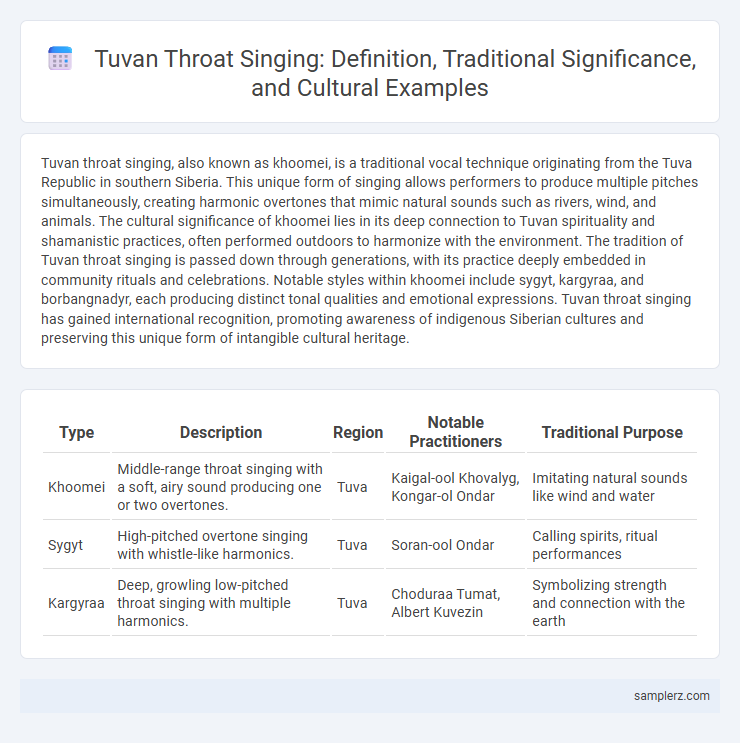Tuvan throat singing, also known as khoomei, is a traditional vocal technique originating from the Tuva Republic in southern Siberia. This unique form of singing allows performers to produce multiple pitches simultaneously, creating harmonic overtones that mimic natural sounds such as rivers, wind, and animals. The cultural significance of khoomei lies in its deep connection to Tuvan spirituality and shamanistic practices, often performed outdoors to harmonize with the environment. The tradition of Tuvan throat singing is passed down through generations, with its practice deeply embedded in community rituals and celebrations. Notable styles within khoomei include sygyt, kargyraa, and borbangnadyr, each producing distinct tonal qualities and emotional expressions. Tuvan throat singing has gained international recognition, promoting awareness of indigenous Siberian cultures and preserving this unique form of intangible cultural heritage.
Table of Comparison
| Type | Description | Region | Notable Practitioners | Traditional Purpose |
|---|---|---|---|---|
| Khoomei | Middle-range throat singing with a soft, airy sound producing one or two overtones. | Tuva | Kaigal-ool Khovalyg, Kongar-ol Ondar | Imitating natural sounds like wind and water |
| Sygyt | High-pitched overtone singing with whistle-like harmonics. | Tuva | Soran-ool Ondar | Calling spirits, ritual performances |
| Kargyraa | Deep, growling low-pitched throat singing with multiple harmonics. | Tuva | Choduraa Tumat, Albert Kuvezin | Symbolizing strength and connection with the earth |
Origins of Tuvan Throat Singing in Cultural Tradition
Tuvan throat singing, or khoomei, originates from the indigenous Turkic peoples of the Tuva Republic in Siberia, deeply rooted in their animistic and shamanistic practices. The tradition reflects a profound spiritual connection to nature, where singers imitate sounds of the environment such as flowing rivers, wind, and animal calls. This ancient vocal technique, passed down through generations, plays a crucial role in ceremonies and rituals, preserving the cultural identity and oral history of the Tuvan people.
Ritual and Spiritual Roles of Throat Singing
Tuvan throat singing, known as Khoomei, holds profound ritual and spiritual significance within traditional communities, serving as a conduit for connecting with nature and ancestral spirits. Practitioners employ harmonic overtones to mimic natural sounds like rivers and mountains, facilitating trance states during shamanic ceremonies and rites of passage. This vocal art form embodies the Tuvan cosmology, reinforcing communal identity and spiritual harmony between humans and the environment.
Traditional Occasions Featuring Tuvan Throat Singing
Tuvan throat singing, or khoomei, is prominently showcased during traditional festivals such as the Naadym festival and the winter shamanic ceremonies in Tuva. These occasions emphasize spiritual connection and cultural heritage, where khoomei performers imitate natural sounds symbolizing animals and the environment. The performance serves not only as entertainment but also as a ritualistic practice reinforcing community identity and ancestral reverence.
Regional Variations in Tuvan Throat Singing Styles
Tuvan throat singing, or khoomei, exhibits distinct regional variations across the Republic of Tuva, with styles such as the sygyt from the western Sayan Mountains characterized by high-pitched, whistle-like overtones and the kargyraa from the southern steppe featuring deep, growling undertones. The Khemchik region's signature style emphasizes a rich, pulsating drone, while the eastern Todzhinsky district is known for its intricate, multi-tonal techniques that mimic natural sounds. These variations reflect local landscapes, spiritual practices, and cultural identities, preserving diverse vocal traditions within Tuvan communities.
Instruments Accompanying Throat Singing in Tuvan Culture
Tuvan throat singing, known as khoomii, is traditionally accompanied by instruments such as the igil, a two-stringed bowed lute, and the doshpuluur, a three-stringed plucked instrument. These instruments provide a harmonic and rhythmic foundation that complements the singer's overtone melodies, enhancing the spiritual and natural themes central to Tuvan culture. The morin khuur, a horsehead fiddle, is also occasionally used, adding a resonant and expressive layer to the throat singing performance.
Integration of Nature and Environment in Throat Singing
Tuvan throat singing, known as khoomii, intricately weaves natural sounds and environmental elements into vocal performance, mimicking the harmonics of rivers, wind, and animal calls. This traditional art form reflects a deep spiritual connection to the Central Asian steppe and its ecosystems, highlighting the symbiotic relationship between humans and nature. By channeling natural acoustics, Tuvan singers preserve and celebrate the cultural identity rooted in their landscape.
The Role of Storytelling in Tuvan Throat Singing
Tuvan throat singing, known as khoomii, intricately intertwines with storytelling to preserve the history and spiritual beliefs of the Tuvan people. Each melodic overtone mimics natural sounds, conveying narratives about landscapes, animals, and ancestral myths central to Tuvan culture. This oral tradition sustains cultural identity by transforming stories into vivid auditory experiences rich with symbolism and emotion.
Throat Singing in Tuvan Social Gatherings and Celebrations
Tuvan throat singing, known as khoomii, is a central element of social gatherings and celebrations among the Tuvan people, often performed during festivals, weddings, and communal hunts. This vocal art form embodies spiritual connections to nature, using harmonic overtones to mimic sounds of the environment, enhancing the cultural significance of traditional events. Performers and audiences alike engage in this practice as a means of preserving heritage and strengthening community bonds.
Transmission of Throat Singing Across Tuvan Generations
Tuvan throat singing, or Khoomei, is traditionally passed down through oral transmission within families and close communities, preserving its distinctive overtone techniques. Elders demonstrate and teach the complex vocal styles during communal gatherings, ensuring the continuity of this unique cultural expression. Today, efforts to document and promote Khoomei through festivals and educational programs support intergenerational knowledge transfer.
Preservation of Throat Singing Traditions in Modern Tuvan Society
Tuvan throat singing, or khoomii, remains a vital cultural practice preserved through community festivals, music schools, and intergenerational teaching in modern Tuva. Efforts by organizations like the Center for Traditional Tuvan Culture promote the art form both locally and internationally, ensuring its transmission to younger generations. Contemporary Tuvan musicians blend traditional techniques with modern genres, sustaining the relevance and longevity of throat singing traditions.

example of Tuvan throat singing in tradition Infographic
 samplerz.com
samplerz.com